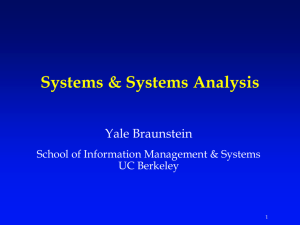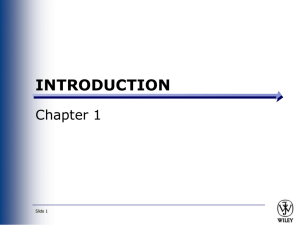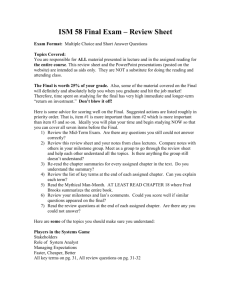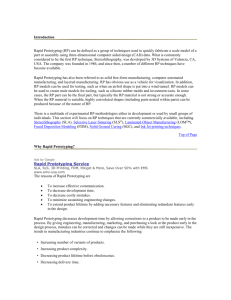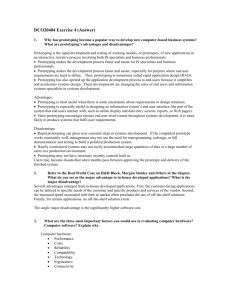2.2 MB - University of Washington
advertisement
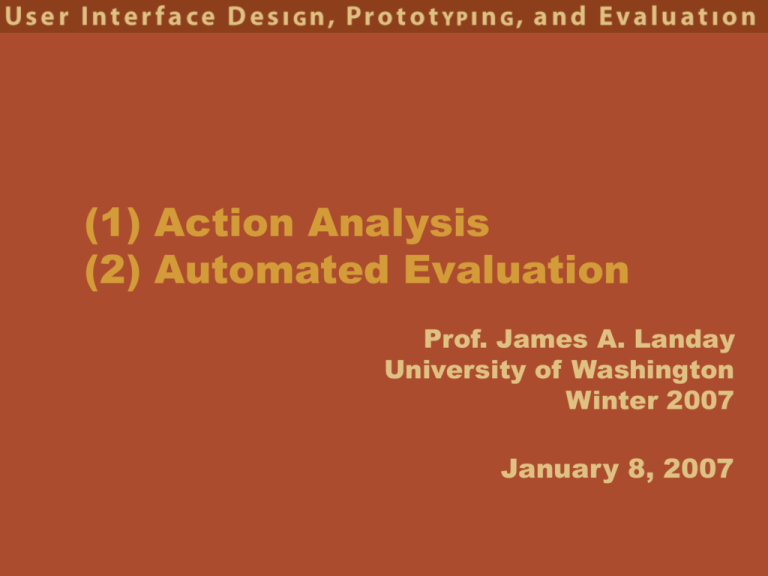
(1) Action Analysis (2) Automated Evaluation Prof. James A. Landay University of Washington Winter 2007 January 8, 2007 Hall of Fame or Hall of Shame? • Bryce 2 – for building 3D models 1/8/2006 CS490f II - User Interface, Design, Prototyping, & Evaluation 2 Hall of Shame! • Icons all look similar – what do they do???? • How do you exit? • Note – nice visuals, but must be usable • What if purely for entertainment & exploration? 1/8/2006 CS490f II - User Interface, Design, Prototyping, & Evaluation 3 (1) Action Analysis (2) Automated Evaluation Prof. James A. Landay University of Washington Winter 2007 January 8, 2007 Outline • • • • • • Action analysis GOMS? What’s that? The G, O, M, & S of GOMS How to do the analysis Announcements Automated evaluation tools 1/8/2006 CS490f II - User Interface, Design, Prototyping, & Evaluation 5 Action Analysis Predicts Performance • Cognitive model – model some aspect of human understanding, knowledge, intentions, or processing – two types • competence – predict behavior sequences • performance – predict performance, but limited to routine behavior • Action analysis uses performance model to analyze goals & tasks – generally done hierarchically (similar to TA) 1/8/2006 CS490f II - User Interface, Design, Prototyping, & Evaluation 6 GOMS – Most Popular AA Technique • Family of UI modeling techniques – based on Model Human Processor • GOMS stands for (?) – – – – Goals Operators Methods Selection rules • Input: detailed description of UI/task(s) • Output: qualitative & quantitative measures 1/8/2006 CS490f II - User Interface, Design, Prototyping, & Evaluation 7 Quick Example • Goal (the big picture) – go from hotel to the airport • Methods (or subgoals)? – walk, take bus, take taxi, rent car, take train • Operators (or specific actions) – locate bus stop; wait for bus; get on the bus;... • Selection rules (choosing among methods)? – Example: Walking is cheaper, but tiring and slow – Example: Taking a bus is complicated abroad 1/8/2006 CS490f II - User Interface, Design, Prototyping, & Evaluation 8 Goals • Something the user wants to achieve • Examples? – go to airport – delete file – create directory • Hierarchical structure – may require many subgoals 1/8/2006 CS490f II - User Interface, Design, Prototyping, & Evaluation 9 Methods • Sequence of steps to accomplish a goal – goal decomposition – can include other goals • Assumes method is learned & routine • Examples – drag file to trash – retrieve from long-term memory command 1/8/2006 CS490f II - User Interface, Design, Prototyping, & Evaluation 10 Operators • Specific actions (small scale or atomic) • Lowest level of analysis – can associate with times • Examples – – – – – 1/8/2006 Locate icon for item on screen Move cursor to item Hold mouse button down Locate destination icon User reads the dialog box CS490f II - User Interface, Design, Prototyping, & Evaluation 11 Selection Rules • If > 1 method to accomplish a goal, Selection rules pick method to use • Examples – IF <condition> THEN accomplish <GOAL> – IF <car has automatic transmission> THEN <select drive> – IF <car has manual transmission> THEN <find car with automatic transmission> 1/8/2006 CS490f II - User Interface, Design, Prototyping, & Evaluation 12 GOMS Output • Execution time – add up times from operators – assumes ? • experts (mastered the tasks) & error free behavior – very good rank ordering – absolute accuracy ~10-20% • Procedure learning time (NGOMSL only) – accurate for relative comparison only – doesn’t include time for learning domain knowledge 1/8/2006 CS490f II - User Interface, Design, Prototyping, & Evaluation 13 GOMS Output Used To • Ensure frequent goals achieved quickly • Making hierarchy is often the value – functionality coverage & consistency • does UI contain needed functions? • consistency: are similar tasks performed similarly? – operator sequence • in what order are individual operations done? 1/8/2006 CS490f II - User Interface, Design, Prototyping, & Evaluation 14 How to do GOMS Analysis • Generate task description – pick high-level user Goal – write Method for accomplishing Goal - may invoke subgoals – write Methods for subgoals • this is recursive • stops when Operators are reached • Evaluate description of task • Apply results to UI • Iterate! 1/8/2006 CS490f II - User Interface, Design, Prototyping, & Evaluation 15 Comparative Example - DOS • Goal: Delete a File • Method for accomplishing goal of deleting file – retrieve from Long term memory that command verb is “del” – think of directory name & file name and make it the first listed parameter – accomplish goal of entering & executing command – return with goal accomplished 1/8/2006 CS490f II - User Interface, Design, Prototyping, & Evaluation 16 Comparative Example - Mac • Goal: Delete a File • Method for accomplishing goal of deleting file – find file icon – accomplish goal of dragging file to trash – return with goal accomplished 1/8/2006 CS490f II - User Interface, Design, Prototyping, & Evaluation 17 Comparative Example - DOS • Goal: Remove a directory • Method for accomplishing goal of removing a directory – ????? 1/8/2006 CS490f II - User Interface, Design, Prototyping, & Evaluation 18 Comparative Example - DOS • Goal: Remove a directory • Method for accomplishing goal of removing a directory – accomplish goal of making sure directory is empty – retrieve from long term memory that command verb is ‘RMDIR’ – think of directory name and make it the first listed parameter – accomplish goal of entering & executing command – return with goal accomplished 1/8/2006 CS490f II - User Interface, Design, Prototyping, & Evaluation 19 Comparative Example - Mac • Goal: Remove a directory • Method for accomplishing goal of removing a directory – ???? 1/8/2006 CS490f II - User Interface, Design, Prototyping, & Evaluation 20 Comparative Example - Mac • Goal: Remove a directory • Method for accomplishing goal of removing a directory – find folder icon – accomplish goal of dragging folder to trash – return with goal accomplished • Note the consistency with delete file on the Mac! This makes it much easier. 1/8/2006 CS490f II - User Interface, Design, Prototyping, & Evaluation 21 Applications of GOMS • Compare different UI designs • Profiling (time) • Building a help system? Why? – modeling makes user tasks & goals explicit – can suggest questions users might ask & the answers 1/8/2006 CS490f II - User Interface, Design, Prototyping, & Evaluation 22 What GOMS Can Model • Task must be goal-directed – some activities are more goal-directed • creative activities may not be as goal-directed • Task must use routine cognitive skills – as opposed to problem solving – good for things like machine operators • Serial & parallel tasks (CPM-GOMS) 1/8/2006 CS490f II - User Interface, Design, Prototyping, & Evaluation 23 Real-world GOMS Applications • Keystroke Level Model (KLM) – Mouse-based text editor – Mechanical CAD system • NGOMSL – TV control system – Nuclear power plant operator’s associate • CPM-GOMS – Telephone operator workstation 1/8/2006 CS490f II - User Interface, Design, Prototyping, & Evaluation 24 Advantages of GOMS • • • • • Gives qualitative & quantitative measures Model explains the results Less work than user study – no users! Easy to modify when UI is revised Research: tools to aid modeling process since it can still be tedious 1/8/2006 CS490f II - User Interface, Design, Prototyping, & Evaluation 25 Disadvantages of GOMS • • • • Not as easy as HE, guidelines, etc. Takes lots of time, skill, & effort Only works for goal-directed tasks Assumes tasks performed by experts without error • Does not address several UI issues, – readability, memorizability of icons, commands 1/8/2006 CS490f II - User Interface, Design, Prototyping, & Evaluation 26 Announcements • Teams – Don’t Forget – Cluster • • • • • • • • Carolyn Sierra Fred Chris Andy Kenneth Elisabeth Kevin – Panlingual Mobile Camera • • • • • Jonathan Tim Martin Peter Kinsley • 1st homework due Friday – update Denim prototype based on HE results & other issues you are aware of • Questions? 1/8/2006 CS490f II - User Interface, Design, Prototyping, & Evaluation 27 Rapid Iterative Design is the Best Practice for Creating Good UIs We have seen how computer-based tools can improve the Design (e.g., Denim) & Prototyping (e.g., VB) phases Design Prototyping Evaluation 1/8/2006 CS490f II - User Interface, Design, Prototyping, & Evaluation 28 Automated GOMS Tools • Can save, modify & re-use the model • Automation of execution time calculation, etc. 1/8/2006 CS490f II - User Interface, Design, Prototyping, & Evaluation 29 QGOMS tool 1/8/2006 CS490f II - User Interface, Design, Prototyping, & Evaluation 30 CRITIQUE Hudson et al (1999) 1. Prototype system – in this case with the SubArctic toolkit 2. Demonstrate a procedure (task) – record events – apply rules 3. Automatically generate KLMs 4. Semi-automatically generate classic GOMS models 1/8/2006 CS490f II - User Interface, Design, Prototyping, & Evaluation 31 Factors Driving Repeat Visits Should Drive Evaluation • High quality content • Ease of use • Quick to download 75% 66% 58% (Source: Forrester Research, 1/99) 1/8/2006 CS490f II - User Interface, Design, Prototyping, & Evaluation 32 Warning I was a founder of the following company – watch for bias! The Trouble With Current Site Analysis Tools Leave 1/8/2006 Unknowns • Who? • What? • Why? • Did they find it? • Satisfied? CS490f II - User Interface, Design, Prototyping, & Evaluation 34 NetRaker Provided User-centric Remote Evaluation Using Key Metrics • NetRaker Index – short pop-up survey shown to 1 in n visitors – on-going tracking & evaluation data • Market Research & Usability Templates – surveys & task testing – invitation delivered through email, links, or pop-ups 1/8/2006 CS490f II - User Interface, Design, Prototyping, & Evaluation 35 NetRaker Usability Research: See how customers accomplish real tasks on site 1/8/2006 CS490f II - User Interface, Design, Prototyping, & Evaluation 36 NetRaker Usability Research: See how customers accomplish real tasks on site 1/8/2006 CS490f II - User Interface, Design, Prototyping, & Evaluation 37 NetRaker Usability Research: See how customers accomplish real tasks on site 1/8/2006 CS490f II - User Interface, Design, Prototyping, & Evaluation 38 WebQuilt: Visual Analysis • Goals – link page elements to user actions – identify behavior/navigation patterns – highlight potential problems areas • Solution – interactive graph based on web content • nodes represent web pages • edges represent aggregate traffic between pages – – – – designers can indicate expected paths color code common usability interests filtering to show only target participants use zooming for analyzing data at varying granularity 1/8/2006 CS490f II - User Interface, Design, Prototyping, & Evaluation 39 1/8/2006 CS490f II - User Interface, Design, Prototyping, & Evaluation 40 1/8/2006 CS490f II - User Interface, Design, Prototyping, & Evaluation 41 1/8/2006 CS490f II - User Interface, Design, Prototyping, & Evaluation 42 Advantages of Remote Usability Testing • Fast – can set up research in 3-4 hours – get results in 36 hours • More accurate – can run with large samples (50-200 users -> stat. sig.) – uses real people (customers) performing tasks – natural environment (home/work/machine) • Easy-to-use – templates make setting up easy • Can compare with competitors – indexed to national norms 1/8/2006 CS490f II - User Interface, Design, Prototyping, & Evaluation 43 Disadvantages of Remote Usability Testing • Miss observational feedback – facial expressions – verbal feedback (critical incidents) • Need to involve human participants – costs some amount of money (typically $20$50/person) • People often do not like pop-ups – need to be careful when using them 1/8/2006 CS490f II - User Interface, Design, Prototyping, & Evaluation 44 Summary • GOMS – provides info about important UI properties – doesn’t tell you everything you want to know about UI • only gives performance for expert, error-free behavior – hard to create model, but still easier than user testing • changing later is much less work than initial generation • Automated usability – – – – faster than traditional techniques can involve more participants convincing data easier to do comparisons across sites tradeoff with losing observational data 1/8/2006 CS490f II - User Interface, Design, Prototyping, & Evaluation 45 Next Time • Advanced User Testing – Appendix A from The Design of Sites – Gomoll paper – Statistica Ch1, and parts of Ch3 – Lewis & Rieman Ch. 5 1/8/2006 CS490f II - User Interface, Design, Prototyping, & Evaluation 46 BACKUP 1/8/2006 CS490f II - User Interface, Design, Prototyping, & Evaluation 47 Max – WebCriteria’s GOMS Model • Predicts how long information seeking tasks would take on a particular web site • Automated procedure: seed with start page and goal page procedure reads page model predicts how long to find & click proper link load time, scan time, and mouse movement time repeat until find goal page • Claim time is directly related to usability 1/8/2006 CS490f II - User Interface, Design, Prototyping, & Evaluation 48 Advantages of Max-style Model • Inexpensive (no users needed) • Fast (robot runs & then computes model) • Can run on many sites & compare -> benchmarks 1/8/2006 CS490f II - User Interface, Design, Prototyping, & Evaluation 49 Disadvantages of Max-style Model • Focus on time (much of it download time) – only 3rd in important factors driving repeat visits – can’t tell you anything about your content – doesn’t say anything directly about usability problems • Robots aren’t humans – doesn’t make mistakes • remember, GOMS assumes expert behavior! – doesn’t account for understanding text – only tries the best path – users will use many • Major flaw is the lack of real users in the process 1/8/2006 CS490f II - User Interface, Design, Prototyping, & Evaluation 50 NetRaker Index: On-going customer intelligence gathering • Small number of rotated questions increases response rate 1/8/2006 CS490f II - User Interface, Design, Prototyping, & Evaluation 51 NetRaker Index: On-going customer intelligence gathering • Small number of rotated questions increases response rate 1/8/2006 CS490f II - User Interface, Design, Prototyping, & Evaluation 52 NetRaker Index: On-going customer intelligence gathering • Small number of rotated questions increases response rate 1/8/2006 CS490f II - User Interface, Design, Prototyping, & Evaluation 53 NetRaker Index: On-going customer intelligence gathering • Small number of rotated questions increases response rate 1/8/2006 CS490f II - User Interface, Design, Prototyping, & Evaluation 54 NetRaker Index: On-going customer intelligence gathering • Increasing these indices (e.g., retention) moderately (5%) leads to a large increase in revenue growth 1/8/2006 CS490f II - User Interface, Design, Prototyping, & Evaluation 55

